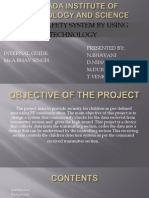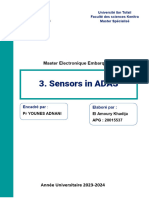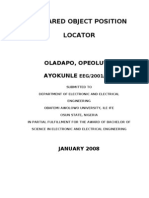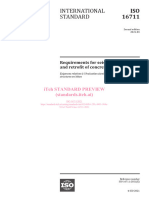V4i2 1698
V4i2 1698
Uploaded by
Ariya AkramCopyright:
Available Formats
V4i2 1698
V4i2 1698
Uploaded by
Ariya AkramOriginal Title
Copyright
Available Formats
Share this document
Did you find this document useful?
Is this content inappropriate?
Copyright:
Available Formats
V4i2 1698
V4i2 1698
Uploaded by
Ariya AkramCopyright:
Available Formats
V Veena et.
al; International Journal of Advance Research, Ideas and Innovations in Technology
ISSN: 2454-132X
Impact factor: 4.295
(Volume 4, Issue 2)
Available online at: www.ijariit.com
GPS and GSM based geo location guide using RF with
emergency alert via SMS
Veena V Vidhiyalukshmi G
veena2733@gmail.com vidhiyagnaanapandithan@gmail.com
Panimalar Engineering College, Chennai, Tamil Nadu Panimalar Engineering College, Chennai, Tamil Nadu
Rajalakshmi R Dr. S. Leones Sherwin
rajalakshmi081997@gmail.com sherwin_leo@yahoo.com
Panimalar Engineering College, Chennai, Tamil Nadu Panimalar Engineering College, Chennai, Tamil Nadu
ABSTRACT
The people entering a theme park are provided with a small unit called as RF receiver which contains an emergency button.
Whenever the person enters a ride or a game in the theme park, they will be intimated with their location in an LCD receiver,
this is done by an RF transmitter kept in various location with fixed IR sensors, which senses the person and the signal is
transmitted to the receiver. In the receiver, a programmed Arduino decides the location based on the received information and
it is displayed in the LCD display. When there is an emergency they can push a button present on the receiver unit and the
information goes to security as well as controller of the game in the form of the alert message along with the location of the
person using GSM module. Here the location of the person is found using GPS tracker.
Keywords: RadioFrequencyRF, InfraRed IR, Sensor, GSM, GPS.
1. INTRODUCTION
Theme parks/ national parks as well as other huge tourist attractions need directional guides to inform the user about his location
in the area. To solve this issue we here propose a park guidance system using RF technology that works wirelessly to guide user
about his current location. This proves as a very handy and convenient medium for guiding tourists through the park.
This system proposes to replace the “you are here” boards mounted through such parks. Our system uses an RF receiver circuit in
order to track the user. The user may carry the circuit with him. It then consists of RF transmitters placed at various locations
across the park. These transmitters constantly emit RF signals. When the RF receiver circuit carried by user comes in range on an
RF receiver it detects that the user is in range of that particular RF transmitter. This signals it to display the location of the user.
Each location area is identified uniquely by an RF transmitter. When the user enters the area the circuit reads the transmitter code
and displays the location on an LCD screen
The global positioning system has become a common functionality in hand held devices, and therefore, several location-tracking
applications have been developed including continuous location-tracking of elders and children for safety reasons or to prevent
them from being lost, car monitoring and tracking, and intelligent transportation systems.
The GPS is used to obtain the location information of a target. However, most of the above-cited works used either an 802.11
wireless network or the short message service (SMS) to transmit the location information of a target to a tracker. The global
system for mobile communications (GSM) modem and a GPS unit is used to track the location. In this project, we have used this
GSM to communicate with the security in case of an emergency.
Wireless communication is a transfer of information or power between two or more points that are not connected by an electrical
conductor. The most common wireless technologies use radio waves with radio waves distances can be short such as a few meters
for Bluetooth or far as millions of kilometers for deep space radio communication. Here we have used RF transmitter and receiver.
The range of RF frequency is 20 kHz to 300Ghz.It can cover up to a distance of 2 km.
© 2018, www.IJARIIT.com All Rights Reserved Page | 1342
V Veena et.al; International Journal of Advance Research, Ideas and Innovations in Technology
2. SYSTEM REQUIREMENTS
A. HARDWARE CONFIGURATION
RF transmitter
RF receiver
GSM module
GPS
Power regulator
Power supply
LCD display
IR sensor
Bridge rectifier
B. SOFTWARE CONFIGURATION
ARDUINO IDE
PROGRAMMING LANGUAGE: EMBEDDED C
3. EXISTING SYSTEM
This system tackles an RFID based location finding and tracking system. The system is an integral part of navigation aid being
developed for people in a store.This system interacts via wireless communication to locate the position of the user and it informs
the user where he is.It consists of a simple RFID tag which the user has and a fixed transmitter which transmits the location name
and the LCD will be there in the transmitter part. , when the receiver is moving to another location the transmitter in the other part
will intimate the user where he is present. It is used in large public spots. But the user has to notice the location by going near to
the transmitter.
There is no emergency alert in this system, the game controller as to manually check if everyone is safe. Due to the absence of an
alert system accident occur.
Disadvantages
No security features.
Location cannot be intimidated.
Cannot be used in case of emergency.
Ride controller may not monitor the ride passenger all the time.
In high speed rides it is not possible to monitor the individual person.
4. PROPOSED SYSTEM
Some places need directional guides to inform the user about his location in the area. This system proves as a very handy and
convenient medium for guiding tourists through the park. This system is to replace you are here boards mounted through such
parks. It uses an RF receiver circuit in order to show his location. The user may carry the circuit with him.
It then consists of RF transmitters placed at various locations across the park. These transmitters constantly emit RF signals. When
the RF receiver circuit carried by user comes in range on an RF receiver it detects that the user is in range of that particular RF
transmitter.
This signals it to display the location of the user. Each location area is identified uniquely by an RF transmitter. When the user
enters the area the circuit reads the transmitter code and displays the location on an LCD screen. Apart from the existing system,
additionally we have added a global system for mobile communication (GSM) which connects the receiver to the security who
will be receiving an emergency message from the user who uses the receiver.
We have also added Global Positioning system (GPS) which gives the latitude and longitude of the location where the user is
present. This location will be transmitted as a link to the security who can view this through an internet connection.
Advantages
More efficient.
Location can be intimidated if lost.
Can be used in case of emergency
© 2018, www.IJARIIT.com All Rights Reserved Page | 1343
V Veena et.al; International Journal of Advance Research, Ideas and Innovations in Technology
5. MODULES DESCRIPTION
RF transmitter
An RF transmitter module is a small PCB sub-assembly capable of transmitting a radio wave and modulating that wave to carry
data. Transmitter modules are usually implemented alongside a micro controller which will provide data to the module which can
be transmitted. RF transmitters are usually subject to regulatory requirements which dictate the maximum allowable transmitter
power output, harmonics, and band edge requirements.
Transmitter Module
RF Receiver
An RF receiver module receives the modulated RF signal and demodulates it. There are two types of RF receiver modules: super
heterodyne receivers and super-regenerative receivers. Super-regenerative modules are usually low cost and low power designs
using a series of amplifiers to extract modulated data from a carrier wave. Super-regenerative modules are generally imprecise as
their frequency of operation varies considerably with temperature and power supply voltage. Super heterodyne receivers have a
performance advantage over super-regenerative; they offer increased accuracy and stability over a large voltage and temperature
range. This stability comes from a fixed crystal design which in the past tended to mean a comparatively more expensive product.
However, advances in receiver chip design now mean that currently there is little price difference between super heterodyne and
super-regenerative receiver modules.
Receiver Module
© 2018, www.IJARIIT.com All Rights Reserved Page | 1344
V Veena et.al; International Journal of Advance Research, Ideas and Innovations in Technology
GSM (Global System for Mobile Communications, originally Groupe Spécial Mobile) is a standard developed by the European
Telecommunications Standards Institute (ETSI) to describe the protocols for second-generation digital cellular networks used
by mobile devices such as tablets, first deployed in Finland in December 1991.
The Global Positioning System (GPS), originally Navstar GPS, is a satellite-based radio navigation system owned by the United
States government and operated by the United States Air Force. It is a global navigation satellite system that provides geo
location and time information to a GPS receiver anywhere on or near the Earth where there is an unobstructed line of sight to four
or more GPS satellites. RF
Transmitter and Receiver Kit
6. OUTPUT
© 2018, www.IJARIIT.com All Rights Reserved Page | 1345
V Veena et.al; International Journal of Advance Research, Ideas and Innovations in Technology
7. CONCLUSION AND FUTURE ENHANCEMENT
The geo location guide system using RF was implemented successfully which guides the user to track their location and can also
provide help in the emergency situation. This can further be enhanced by converting the text message to speech in the module
which can help blind people and to also make the user get attention when they do some important activities, like when they are
driving in the road and if a speech signal guides them then it will be useful. This text to speech conversion can even be replaced
by using a buzzer which would alarm whenever the user enters into a new location
8. REFERENCES
[1] Design of an Alert scheme using RF technology for Ensuring Safety of Individuals in Wireless Ad-Hoc Network (International
conference for convergence of technology-2014 IEEE) Sharvika PaliwalDepartment of Computer Science and Engineering G. H.
Raisoni Institute of Engineering and Technology for Women's, Nagpur, Maharashtra, India.Ms. V. N. Katkar Department of
Computer Science and Engineering G. H. Raisoni Institute of Engineering and Technology for Women's, Nagpur, Maharashtra,
India.
[2] An RFID Based Location Finding and Tracking with Guidance(2008 IEEE)Rusen Oktem, Elif Uray Aydin Electrical and
Electronic Engineering Department Atilim University Ankara, Turkey Nergiz Ercil Cagiltay Software Engineering Department
Atilim University Ankara, Turkey .
[3] A Tracking System Using Location Prediction and Dynamic Threshold for Minimizing SMS Delivery (journal for
communication and networks, vol.15, no. 1, February 2013 KICS) Yuan-ChengLai, Jian-WeiLin, Yi-HsuanYeh, Ching-NengLai,
andHui-ChuanWeng.
[4] Vaishak.P, T.Sivakumar, "An Efficient Routing Protocol for Minimizing Multi-hop in VANET using WiMAX ", International
Journal of Scientific & Engineering Research, Volume 4, Issue 6, June-2013, ISSN 2229-5518.
© 2018, www.IJARIIT.com All Rights Reserved Page | 1346
You might also like
- Opel Corsa 2024 Manual EnglishDocument355 pagesOpel Corsa 2024 Manual EnglishDan Mihai100% (1)
- Onsite Travel Policy - V 2.1Document15 pagesOnsite Travel Policy - V 2.1Harsh GuptaNo ratings yet
- Reservation of RightsDocument1 pageReservation of RightsJohn Taylor100% (5)
- Geo Location Guide Using RF PROJECTDocument3 pagesGeo Location Guide Using RF PROJECTPodadai VadaNo ratings yet
- Parking Management in Shopping MallsDocument12 pagesParking Management in Shopping MallsadNo ratings yet
- Project Report On Pavement DesignDocument50 pagesProject Report On Pavement Designsagar kumar100% (1)
- Design For Visually Impaired To Work at Industry Using RFID TechnologyDocument5 pagesDesign For Visually Impaired To Work at Industry Using RFID Technologyilg1No ratings yet
- Physics Model DiscriptionDocument5 pagesPhysics Model DiscriptionAbhinav AzadNo ratings yet
- Intelligent Traffic Rule Controller: Nikhil Sonje, Deep Patel, Nirav Raval, Sahil Sejpal, Prof - Sunil PatilDocument3 pagesIntelligent Traffic Rule Controller: Nikhil Sonje, Deep Patel, Nirav Raval, Sahil Sejpal, Prof - Sunil PatilerpublicationNo ratings yet
- Child Safety System by Using RF TechnologyDocument25 pagesChild Safety System by Using RF Technologyaravishankar23No ratings yet
- Applications of RFID Systems - Localization and Speed MeasurementDocument18 pagesApplications of RFID Systems - Localization and Speed MeasurementkasreedharNo ratings yet
- IOT Based Vehicle Speed Control Automatically in RDocument4 pagesIOT Based Vehicle Speed Control Automatically in R7071 PREETHI KAMBLENo ratings yet
- SPY Night Vision Robot With Moving Wireless Video Camera & Ultrasonic SensorDocument6 pagesSPY Night Vision Robot With Moving Wireless Video Camera & Ultrasonic SensorrajeshNo ratings yet
- IOT Asset Tracking System Using Android ApplicationDocument5 pagesIOT Asset Tracking System Using Android ApplicationBhaskar Rao PNo ratings yet
- Infrar ED: TO Sir-:Kuldip KhatriDocument36 pagesInfrar ED: TO Sir-:Kuldip KhatriRaman GuptaNo ratings yet
- Automatic Speed Controlling System Using IoTDocument3 pagesAutomatic Speed Controlling System Using IoTInternational Journal of Innovative Science and Research TechnologyNo ratings yet
- Report On RFIDDocument20 pagesReport On RFIDdar100% (1)
- Vib - An Introduction To Using The RFDocument6 pagesVib - An Introduction To Using The RFMahmoud SobhyNo ratings yet
- Vehicle To Vehicle Communication For Not Reachable Areas: Mahpara Muzafar, Taznoon Khajwal, Rimsha, Falak RashidDocument6 pagesVehicle To Vehicle Communication For Not Reachable Areas: Mahpara Muzafar, Taznoon Khajwal, Rimsha, Falak RashidChethan GowdaNo ratings yet
- Advanced Communication SystemsDocument207 pagesAdvanced Communication SystemsKousalyaNo ratings yet
- RF Controlled Spy Robot With Night Vision CameraDocument7 pagesRF Controlled Spy Robot With Night Vision CameraNikhil GaidhaneNo ratings yet
- A Self-Configurable New Generation School Children Tracking SystemDocument18 pagesA Self-Configurable New Generation School Children Tracking SystemmathstopperNo ratings yet
- Abs On RemoteDocument7 pagesAbs On RemoteRajkumar RNo ratings yet
- Ultrasonic Ranging and Detecting Using ADocument4 pagesUltrasonic Ranging and Detecting Using AMadhav DasNo ratings yet
- RFID-based Mobile Robot Guidance To A Stationary Target: Myungsik Kim, Nak Young ChongDocument13 pagesRFID-based Mobile Robot Guidance To A Stationary Target: Myungsik Kim, Nak Young ChongJayendra SharmaNo ratings yet
- Wirelesss Infra Red Communication Through Ir LedDocument42 pagesWirelesss Infra Red Communication Through Ir LedNitesh Kumar JainNo ratings yet
- Disasters Management and Monitoring Using RFID and GSM TechnologyDocument4 pagesDisasters Management and Monitoring Using RFID and GSM TechnologySrini VasuluNo ratings yet
- Intelligent Smart Zone Based Vehicle Speed Control System Using RFDocument5 pagesIntelligent Smart Zone Based Vehicle Speed Control System Using RFSANGAVI SNo ratings yet
- Ultrasonic Blind Walking StickDocument12 pagesUltrasonic Blind Walking StickVinaya DhavalagiNo ratings yet
- Sensors in ADASDocument7 pagesSensors in ADASKhadija El AmouryNo ratings yet
- Wireless Communication Using RF: D.Kranthi Kumar 06J21A0428Document13 pagesWireless Communication Using RF: D.Kranthi Kumar 06J21A0428dev_raj8981No ratings yet
- Implementation of Model Radar For Target Identification Using Remote Station Alert SystemDocument8 pagesImplementation of Model Radar For Target Identification Using Remote Station Alert SystemIJRASETPublicationsNo ratings yet
- Cellular Signals Jamming System in 2G and 3GDocument6 pagesCellular Signals Jamming System in 2G and 3GChansoriya ImNo ratings yet
- Remote Sensing Beyond ObstaclesDocument9 pagesRemote Sensing Beyond Obstaclesrongrung4567263No ratings yet
- Smart Antenna FYPDocument6 pagesSmart Antenna FYPpremNo ratings yet
- MADA10 16765458966129456163ee0f6888bcdDocument24 pagesMADA10 16765458966129456163ee0f6888bcdHimanshu JaiswalNo ratings yet
- Iot Based Vehicle Speed Control Automatically in Restricted Fry37mfc12Document3 pagesIot Based Vehicle Speed Control Automatically in Restricted Fry37mfc12RANJITHA KNo ratings yet
- 30.IJAEST Vol No 7 Issue No 2 An Intelligent Mobile Robot Navigation Technique Using RFID Technology 356 364Document10 pages30.IJAEST Vol No 7 Issue No 2 An Intelligent Mobile Robot Navigation Technique Using RFID Technology 356 364helpdesk9532No ratings yet
- Vehicle Tracking System Using GpsDocument3 pagesVehicle Tracking System Using GpsDhruv PatelNo ratings yet
- Ubiquitous Networking Full ReportDocument24 pagesUbiquitous Networking Full ReportSurangma ParasharNo ratings yet
- Accident Detection and Prevention System Using GSM & GPS With Traffic Clearence For AmbulanceDocument4 pagesAccident Detection and Prevention System Using GSM & GPS With Traffic Clearence For AmbulanceInternational Journal of Innovative Science and Research TechnologyNo ratings yet
- 7 RemoteMonitoring PDFDocument7 pages7 RemoteMonitoring PDFIjaems JournalNo ratings yet
- Progress in Electromagnetics Research C, Vol. 11, 213-228, 2009Document16 pagesProgress in Electromagnetics Research C, Vol. 11, 213-228, 2009Karloz CondeNo ratings yet
- Bank Locker Security System Using Embedded System Ijariie20480 PDFDocument7 pagesBank Locker Security System Using Embedded System Ijariie20480 PDFDr. Madhumathy PNo ratings yet
- Implementation of Inflight Entertainment System Using Light Fidelity TechnologyDocument8 pagesImplementation of Inflight Entertainment System Using Light Fidelity TechnologyHenish ShahNo ratings yet
- ReportDocument19 pagesReportKuldeep TeekasNo ratings yet
- Fin Irjmets1636371223Document4 pagesFin Irjmets1636371223Ariya AkramNo ratings yet
- Aerotenna Technology White PaperDocument5 pagesAerotenna Technology White PapererdemsecenNo ratings yet
- Infrared Object Position Locator: Oladapo, Opeoluwa AyokunleDocument44 pagesInfrared Object Position Locator: Oladapo, Opeoluwa Ayokunleoopeoluwa_1No ratings yet
- Fpga Based Radar Signal Processing For Automotive Driver Assistance SystemDocument24 pagesFpga Based Radar Signal Processing For Automotive Driver Assistance Systemvishalgupta90No ratings yet
- Rto Based Vehicular Adhoc NetworkDocument28 pagesRto Based Vehicular Adhoc NetworkkiranNo ratings yet
- Smart AntennaDocument17 pagesSmart Antennasegun nwosuNo ratings yet
- A Blind Navigation System Using RFID For Indoor EnvironmentsDocument4 pagesA Blind Navigation System Using RFID For Indoor EnvironmentsPUB G Gamer FamilyNo ratings yet
- Radio WavesDocument22 pagesRadio WavesMargaret SpencerNo ratings yet
- Security Alarm Using Ir TransmitterDocument10 pagesSecurity Alarm Using Ir TransmitterDjbdjNo ratings yet
- Automobile Prototype SensorsDocument5 pagesAutomobile Prototype SensorsIJSTENo ratings yet
- ON Control of Arduino Robot and Different Gadgets Using RF ModuleDocument4 pagesON Control of Arduino Robot and Different Gadgets Using RF ModuleVinod PathakNo ratings yet
- Slides On Military RadarsDocument31 pagesSlides On Military RadarsAnandKushwaha100% (1)
- Wireless Sensor Networks Batch 1 - Assignment 1: Sri Ramachandar K 17EUEC149 Ece-CDocument3 pagesWireless Sensor Networks Batch 1 - Assignment 1: Sri Ramachandar K 17EUEC149 Ece-CSriramachandarNo ratings yet
- Wireless RF Project Report For Web PDFDocument70 pagesWireless RF Project Report For Web PDFpedro100% (1)
- Smart Bus Tracker: K.V. Nagalakshmi, Monisha M, Puja Kaul, Sumaya Bhat, Revathy C Kattepur, Sneha Sara JacobDocument5 pagesSmart Bus Tracker: K.V. Nagalakshmi, Monisha M, Puja Kaul, Sumaya Bhat, Revathy C Kattepur, Sneha Sara Jacobankush belkarNo ratings yet
- Microwave and Millimeter Wave Circuits and Systems: Emerging Design, Technologies and ApplicationsFrom EverandMicrowave and Millimeter Wave Circuits and Systems: Emerging Design, Technologies and ApplicationsNo ratings yet
- RFID at Ultra and Super High Frequencies: Theory and applicationFrom EverandRFID at Ultra and Super High Frequencies: Theory and applicationNo ratings yet
- Concurrent Delays in Construction WorkDocument3 pagesConcurrent Delays in Construction WorkNavam NanthanNo ratings yet
- Alcatel-Lucent Omnipcx Enterprise Communication Server: Abc-Ip Logical LinkDocument46 pagesAlcatel-Lucent Omnipcx Enterprise Communication Server: Abc-Ip Logical Linkjuan50% (2)
- Aec1 Chapter 1Document4 pagesAec1 Chapter 1James Paolo RazalNo ratings yet
- Core - Security.patterns - Best.practices - And.strategies - for.J2EE - Web.services - And.identity - Management.oct.2005 0131463071Document848 pagesCore - Security.patterns - Best.practices - And.strategies - for.J2EE - Web.services - And.identity - Management.oct.2005 0131463071blackstileNo ratings yet
- Lesson 3 PDFDocument2 pagesLesson 3 PDFGemma Joy Sugue AlforqueNo ratings yet
- Iron Carbon Diagram Form The Basis of Heat TreatmentsDocument41 pagesIron Carbon Diagram Form The Basis of Heat TreatmentsMuhammad TalhaNo ratings yet
- Bepattment Ot Butatto": ReqtDocument2 pagesBepattment Ot Butatto": Reqtmaligmichael0115No ratings yet
- CBLT Selected Texts 4eDocument23 pagesCBLT Selected Texts 4emanbani BOGUEMNANo ratings yet
- Alpha JP-501Document4 pagesAlpha JP-501yinNo ratings yet
- Important Medicinal and Aromatic Plants in South East Europe in Relation With Their Medicinal and Other Industrial Utilization Republic of MacedoniaDocument41 pagesImportant Medicinal and Aromatic Plants in South East Europe in Relation With Their Medicinal and Other Industrial Utilization Republic of MacedoniaOana Sidor100% (1)
- PM - SDD - Master Data - V1.0Document13 pagesPM - SDD - Master Data - V1.0Dhanush S T100% (1)
- Formatos 1 Al 15 Con Rpta PDFDocument210 pagesFormatos 1 Al 15 Con Rpta PDFBrian Izarnótegui AltamiranoNo ratings yet
- Iso 16711 2021Document10 pagesIso 16711 2021moayyadali1999No ratings yet
- Session 3Document17 pagesSession 3Rubayat AdnanNo ratings yet
- Entrepreneurship: Characteristics, Importance, Types, and Functions of EntrepreneurshipDocument12 pagesEntrepreneurship: Characteristics, Importance, Types, and Functions of EntrepreneurshipSagar AdhangaleNo ratings yet
- 992 G DiapoDocument14 pages992 G DiapoOriel RoblesNo ratings yet
- Schroeder 2020 IOP Conf. Ser. Earth Environ. Sci. 503 012063Document9 pagesSchroeder 2020 IOP Conf. Ser. Earth Environ. Sci. 503 012063Ana Lucía Guevara JuárezNo ratings yet
- Davao Fruits Corporation vs. Associated Labor Union, 1993Document4 pagesDavao Fruits Corporation vs. Associated Labor Union, 1993Maribel Nicole LopezNo ratings yet
- NOTES 01 - Economic DevelopmentDocument2 pagesNOTES 01 - Economic DevelopmentpoloNo ratings yet
- Control Panel: Xerox Workcentre 5945 / 5955Document14 pagesControl Panel: Xerox Workcentre 5945 / 5955Ganiza LongNo ratings yet
- Crafter Panel Van-BrochureDocument49 pagesCrafter Panel Van-BrochureMircea PostolacheNo ratings yet
- Ping FederateDocument1,160 pagesPing FederateN Reddy KNo ratings yet
- Bhpannualreport2022Document248 pagesBhpannualreport2022ozbrat2000No ratings yet
- (As Filed) DISH Opposition To SpaceX ETC DesignationDocument11 pages(As Filed) DISH Opposition To SpaceX ETC DesignationSimon AlvarezNo ratings yet
- 11 Chapter 7Document69 pages11 Chapter 7shovan1234No ratings yet
- Geo7Series UserGuide PDFDocument133 pagesGeo7Series UserGuide PDFAji SatrioNo ratings yet

























































































